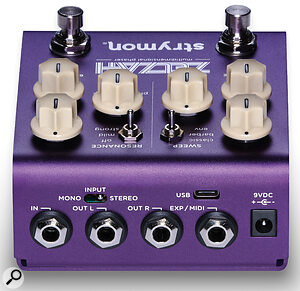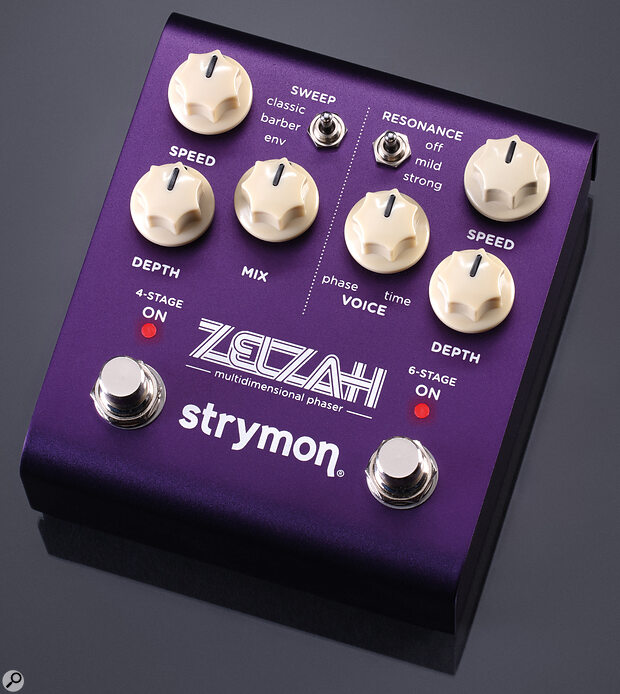The Zelzah will take you to places conventional phasers can only dream of...
The Zelzah is described as a ‘multidimensional phaser’, and at its heart are two separate phasers, one with six stages and the other with four. Each has its own control set and stomp switch, so can be switched on/off individually, but if used in tandem you have a choice of three different routing configurations. This already makes it more versatile than a typical phaser, and due to its ability to deliver wonderful chorus, flanging and almost rotary‑style effects too, it’s perhaps better thought of as a multi‑modulation effect.
As on Strymon’s other more compact pedals, the Zelzah has a single TRS input jack, which caters for unbalanced mono or stereo inputs, and separate left and right output jacks; a small selector switch above the input sets the unit for mono or stereo input sources. It can be set to work with instrument or line‑level signals, and to true or buffered bypass. It’s a digital pedal, with 24‑bit/96kHz conversion and 32‑bit floating‑point processing, and it requires a 300mA or higher 9V DC centre‑negative external supply. With the brilliantly clean sound we’ve come to expect from Strymon, stereo analogue I/O, a MIDI/expression input and configurable routing, it has the potential to be a great tool for producers and performers alike. So let’s take a closer look.
Phase Two
The four‑stage phaser has Speed, Depth and Mix controls and caters for traditional effects, courtesy of three Sweep modes. Classic mode does what it says on the tin: this is a classic four‑stage phaser sound with a touch of ‘vintage’, its movement governed by a single warped‑triangle LFO. Barber Sweep, another familiar sound, creates the impression of the ‘swoosh’ continually rising or falling in one direction. The third mode, Envelope, is interesting: the effect becomes influenced by the dynamics of your playing, and behaves rather like a filter envelope. The Mix control is a welcome feature, as it can be used to achieve different things depending on which Sweep mode is engaged. When set to Classic, for example, the Mix control can be used to dial in everything from a subtle phaser to a full‑on vibrato effect, whereas in Envelope mode higher Mix settings result in pitch modulation. This was really useful used on a guitar in the studio, when I just wanted a small amount of movement implied by the phaser without a fully ‘washed out’ effect.
The six‑stage side of the pedal also has Speed and Depth knobs, but in place of the other side’s Mix control this one features an innovative control called Voice. This adjusts over 30 different parameters in the pedal simultaneously, and can take you pretty quickly to a wide range of different results. Turning the control anticlockwise from the central 12 o’clock position delivers interesting effects, but all very much in phaser territory. Turning it clockwise, on the other hand, takes you into flanger territory, with further moves delivering lush chorus sounds. This control uses what Strymon describe as a “groundbreaking new modified all‑pass structure,” which expands the time response of the cascading all‑pass filters seamlessly and continuously. It sounds complicated but it’s really easy to use, and I found it incredibly useful in the studio since it allowed me to find completely different tones really quickly. I was also surprised how easily I could shift from a vintage phaser to a deep chorus with so few parameters changed.
The six‑stage side also has a resonance switch, the options being Off, Mild and Strong. This determines the amount of feedback in the signal path, with more feedback creating narrower notches and peaks, so resonance is an apt name. It’s a great option to have here (and an unusual but welcome one for the choruses); I did find myself wondering if there might be scope for a more extreme setting, but that’s probably just my taste for sonic destruction showing through!
Routing Flexibility
The routing versatility is wonderful. The Series option feeds the output of the six‑stage effect into the four‑stage one, as if they were two separate pedals connected with patch cords; it’s a simple arrangement but often a pleasing one. In Parallel mode, the input signal is routed to each effect independently, and their outputs are then mixed together to create the pedal’s output signal. When used with a mono input, Split routing runs the signal through both phasers in parallel, but sends the four‑stage phaser out to the left output jack and the six‑stage one to the right. If running a stereo signal into the pedal, Split mode will process the left input through the four‑stage phaser and the right input through the six‑stage effect — with the right input cable, you could process two mono signals independently, one with each phaser.
 A switch on the rear of the Zelzah sets the single TRS input to accept mono or stereo signals.To choose different routing options, you hold one footswitch down when powering on, then use the Voice encoder to make your selection; hidden functions such as this and the instrument/line‑level operation are very clearly described in the manual and easy to access once you know how. I found myself choosing to work in Parallel mode most of the time, since I found that this allowed me to design sounds that held the most appeal for my own style, but all modes could be very enjoyable, and inspiring to write and perform with.
A switch on the rear of the Zelzah sets the single TRS input to accept mono or stereo signals.To choose different routing options, you hold one footswitch down when powering on, then use the Voice encoder to make your selection; hidden functions such as this and the instrument/line‑level operation are very clearly described in the manual and easy to access once you know how. I found myself choosing to work in Parallel mode most of the time, since I found that this allowed me to design sounds that held the most appeal for my own style, but all modes could be very enjoyable, and inspiring to write and perform with.
Whether the input is set to mono or stereo, the pedal can still deliver a stereo signal to the L and R output jacks, though if you only insert a jack into the L output, the output signal will be mono. Speaking of stereo signals, the pedal supports true stereo (the L and R inputs can each be processed by both the effects engines), and the stereo width of each phaser can be edited independently — another nice touch, which allows you to create some really wild, wide, spacious effects.
External Control & Sync
As is common with pedals of this size, a single quarter‑inch jack socket is used for MIDI inputs or for expression/switch pedal support, though MIDI can also be received over USB, which is also used to update the firmware.
The Zelzah can have any of its onboard parameters controlled by an expression pedal, and setting one up is as simple as configuring the pedal to your desired settings when the expression pedal is at its heel and toe points. MIDI CC messages can similarly be used in place of the top‑panel controls, or to change the routing mode, stereo spread, remote tap and footswitch functions — essentially, everything this pedal can do can be controlled by MIDI. This means that it’s right at home in a large rig which employs a MIDI control system, or in a DAW‑based production environment where you can easily use MIDI for automation and recall.
With an expression pedal, I found I could... raise the rate and depth to create a Leslie‑esque speed‑up sound.
The Zelzah can store up to 300 presets, and these can either be accessed using MIDI, or made available for selection using Strymon’s own MultiSwitch Plus pedal. As with their other pedals, the company’s Favorite switch can also be used to select a favourite setting. Tap mode also allows you to use an external switch to tap in the tempo of the six‑stage phaser, which is a nice touch. And the LFOs can also be sync’ed to MIDI Clock, of course, in which case the speed knobs act as multipliers or dividers of the tempo.
In Use
I’m a big fan of easy‑to‑use pedals and, despite its internal sophistication, the Zelzah certainly fits that description: two separate effects with bags of options to discover using a minimal control set? Perfect. It has a very clean sound, which is a good thing in general, but some might feel that it would benefit from some onboard drive or saturation controls — anyone who wants a grittier‑sounding solution will need to pair it with another pedal; for example, I enjoyed some great results using it alongside an Electronic Audio Experiments Model FET.
The really special thing about the Zelzah was that the more I used it, the more I seemed to discover. I was constantly surprised by just how many different sounds I could access with what had initially seemed like a pretty simple pedal, and the routing options were surprisingly creative tools — a really thoughtful touch. I’m a guitar player as well as an engineer, so it’s perhaps not surprising that I spent a lot of my time putting the Zelzah through its paces on guitar, but I also enjoyed it a lot on synths, electronic pianos and organs. The ability to add subtle movement so easily using the Mix control is fantastic, of course, but you can go a lot deeper. With an expression pedal, for example, I found I could not only ‘swing into’ something weird from a normal setting, but even slowly raise the rate and depth to create a Leslie‑esque speed‑up sound. The Zelzah can also provide great sound‑design inspiration: just crank the rate and speed up and mess with the switches, and you’ll find plenty of happy accidents.
I am a fan of both vintage‑inspired phasers and modulation effects more generally, and I’ve loved putting the Zelzah through its paces. Ultimately, it is a phaser‑based pedal, but a really versatile one with the added bonus of flanger, chorus and potentially even Leslie‑style effects — even if it’s not an outright replacement for other dedicated modulation effects. Importantly, as well as sounding good, it’s always really easy to use. If you’re into lush phasing effects, the Zelzah is well worth a test drive.
Summary
A powerful and versatile pedal, the Zelzah may be a phaser at heart, but it covers lots of modulation bases: chorus, lo‑fi, rotary, ’80s, modern... it’s all there!
Information
£329 including VAT.
MusicPsych Limited +44 (0)207 607 6005.
$349


